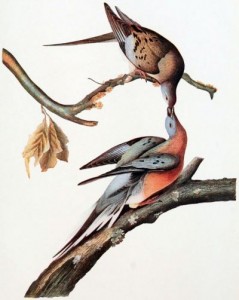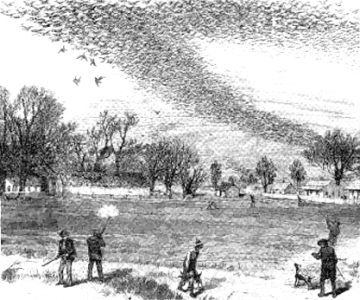“The air was literally filled with pigeons; the light of noonday was obscured as by an eclipse; . . . pigeons were still passing in undiminished numbers, and continued to do so for three days in succession.”
John James Audubon, 1813

Female (above) and male (below); Mershon’s The Passenger Pigeon (Audubon plate, crop) by John James Audubon 1824 via Wikimedia Commons.
Few if any humans alive today would remember what was once the most numerous bird species in North America. Indeed, few of us even know its name. Today, September 1st, 2014, marks a sad but important milestone, the exact 100th anniversary of the extinction of the Passenger Pigeon, a species that once numbered about 3 to 5 billion individuals, accounting for about a quarter of all birds in North America.
Passenger Pigeons were an entirely different species than the Rock Pigeons commonly seen now in urban areas around Vancouver, and different too than the Band-tailed Pigeon in forests along coastal BC. They looked more like Mourning Doves than either of these, but were much larger, with very long tails and wings. Passenger Pigeons travelled in immense flocks across eastern North America, nesting and roosting in deciduous forests. There are a few scattered records from BC and other western areas as well.

By Louis Agassiz Fuertes – Birds of New York (New York State Museum. Memoir 12), Albany: University of the State of New York. via Wikimedia Commons.
Up until the late 1800’s, there were so many Passenger Pigeons that people viewed them as a never-ending resource. Humans hunted them for food, for feathers used in mattresses, and for agricultural fertilizer. They also hunted them purely for sport, in some cases catching them for live trap shooting. In one hunt in Michigan, 50,000 Passenger Pigeons were killed each day for five months straight.

Passenger pigeon hunt in 1875 by The Illustrated Shooting and Dramatic News via Wikimedia Commons.
Finally, in the 1890’s, some people realized that humans might be causing the unthinkable: the elimination of the most abundant bird species in North America. Laws were passed to protect the species. But it was too late: numbers of Passenger Pigeons continued to decline, due in part to the destruction of their nesting habitat as well as their numbers passing below the needed density for communal breeding.
Long after they were extinct in the wild, the last captive Passenger Pigeon, a female named Martha, died of old age at 1 p.m. on September 1st, 1914, in the Cincinnati Zoo. This moment marked a remarkable milestone for humanity: as an early case in which the exact date of a human-caused extinction is known, it showed our actions can have extreme consequences, forever altering fundamental characteristics of the natural environment.

Martha, the last Passenger Pigeon by Enno Meyer via Wikimedia Commons.
A remarkable fact about a species’ extinction is that it not only eliminates a species from the face of the Earth, but it also marks the moment at which all knowledge and memory of that species starts to fade. As I start my tenure today as Acting Director of the Beaty Biodiversity Museum for one year. I will keep Martha foremost in my thoughts, as she is a vital reminder of the importance of museums as centers of knowledge and concern for the natural world.
